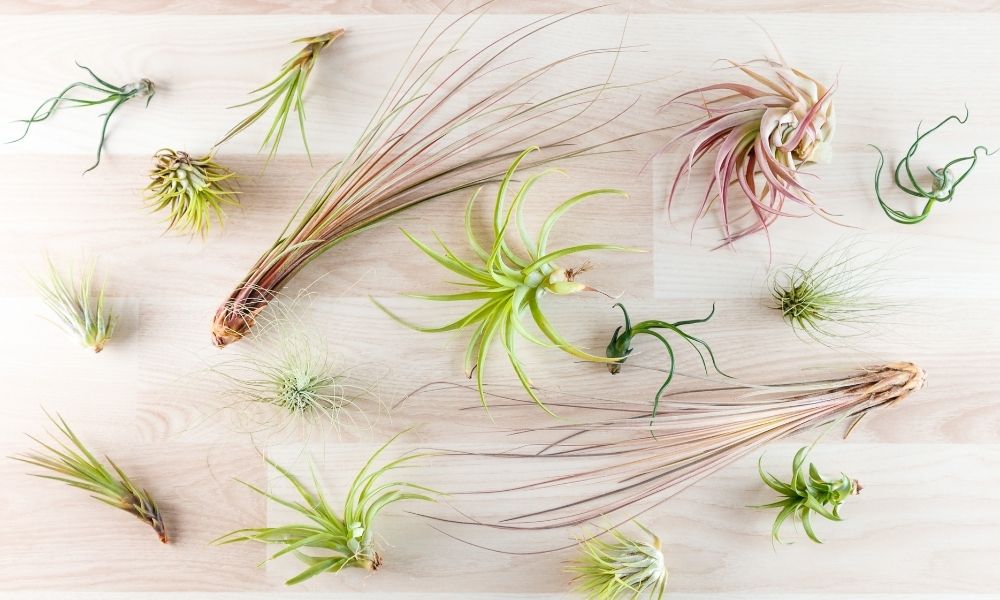Air Plants
We all learned how plants work in elementary school. You put the roots in soil, water it, place it in sunlight, let photosynthesis do its thing, and it grows. But air plants? These little guys defy everything you know about gardening.
For one, they don’t need soil, just air. They do need some water and sunlight, but not nearly as much as normal plants. They come in a surprising amount of shapes and sizes and have this alien-like look to them, but if you give them a chance I promise they’ll grow on you.
What Are Air Plants?
As their name suggests, air plants thrive without soil. They’re flowering perennials that have a tendency to cling to anything and everything, from branches and rocks to telephone wires and buildings. These unique little flowers survive by absorbing nutrients and water from the air around them.
Air plants are exclusively from the Tillandsia genus, so if you’re trying to impress someone, throw out the name Tillandsia when pointing to an air plant, and 10 out of 10 times you’ll be right.
With over 600 species of Tillandsia, air plants are native to South America, Central America, Mexico, and the southeastern United States. With so much variety, you’ll easily find one that speaks to you (or fits your home decor).
Care
- Plant Size: Depending on the variety you purchase, air plants can range in size from two inches to seven feet! Don’t worry — most indoor varieties are only two to five inches in circumference.
- Light: Generally, keep them indoors and away from direct sunlight; bright indirect light and slight shade are perfect. Pro tip: silver-leafed air plants can tolerate the sun better than their green- or red-leafed counterparts.
- Water: Submerge them in water for 30 minutes every 1 to 2 weeks, then flip them upside-down and allow them to drain on a towel. Once dry, they’re good to go. You can also mist them with fresh water every few days to keep them looking healthy and fresh. This is especially important if you live in a dry climate. In cooler weather, they only need to be submerged once every 3 to 4 weeks.
- Temperature: These plants love warm weather, so anything below 45 degrees (F) is dangerous, and frost is their mortal enemy.

Why Choose Air Plants for Your Home?
You might want to adopt an air plant because they require almost no effort to maintain. Air plants are known for being resilient and low maintenance, making them some of the easiest plants to care for.
If you’re definitely not a green thumb and have trouble keeping things alive, but still want a splash of nature in your living room, air plants are for you. Air plants don’t even need much water, just a misting and occasional soak (more on that later).
Plus, air plants are extremely versatile because without soil they can fit almost anywhere. Display them in glass globes (terrariums), on a bookshelf, windowsill, or coffee table. Hang them from the ceiling with fishing line or hot glue them to a wood board. I’m not kidding; they can go virtually anywhere.
Air Plant Family Relatives
Air plants, or Tillandsia plants *pushes up glasses*, share some DNA with the following species:
- Nephrolepis – A family of about 30 different ferns, including the Lemon Butter Fern.
- Bromeliads – A massive family of flowering plants that includes over 3,500 species! They’re mostly native to the tropical Americas.
Final Thoughts
Air plants, the plant for self-proclaimed plant killers. Even if they’re overdue for a proper watering or misting, they’ll forgive you. Leave them on a shelf for two weeks? No problem, they’ll live on. Glue them to a board to be displayed at a wedding? Sure, they can take it.
But as with any healthy plant relationship, they’ll thrive if you learn to read their signals. Submerge them in water every week, give them a mist every few days, and they’ll reward you with healthy leaves and maybe even bloom a flower.
Air plants aren’t like normal plants, but that’s the novelty of them. They don’t need soil and look like spiny, curly, wavy lumps from another planet. However, they’re also easy to care for, ultra-versatile decor, perfectly Instagrammable, and at the end of the day – enduringly cute.